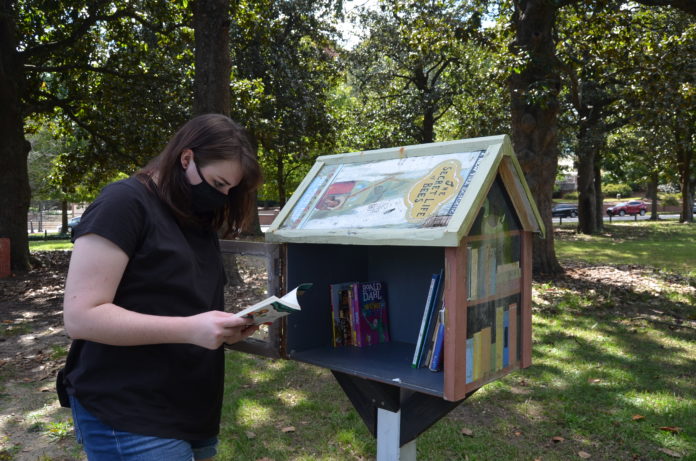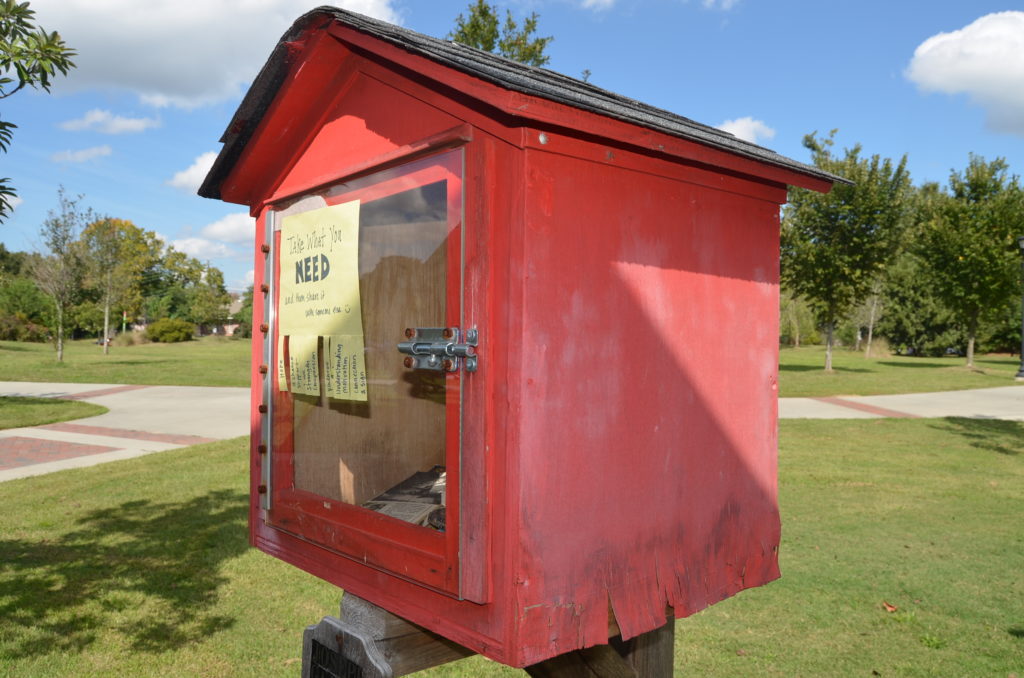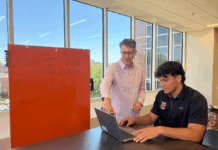
Thirty-six Mercer University students are studying, stocking and cataloguing books for Little Free Libraries in Macon.
Dr. Tom Bullington, lecturer of liberal arts at Mercer for three years now, developed this new service learning project for his Integrative Curriculum (INT) 201: Building Community courses this fall.
Little Free Libraries are book-sharing boxes installed outside. People can take books they’re interested in reading and donate books for the supply. Library locations can be registered and listed online for a fee, but only one of Macon’s boxes currently is on the map.
Divided into groups of three or four for two sections of the course, Dr. Bullington’s students are working with six Little Libraries in the city, most within walking distance of the Mercer campus. Some have been well-maintained while others sit empty. The students began the project by cataloguing the author, title, date of publication and genre of every book in their libraries. Now, they’re visiting their sites each week to record new books that have come in and ones that are gone. They are also responsible for restocking the boxes if supply gets low.
“It’s a case study for people’s taste. What would happen if people had access to this media just sitting out there in a nice, decorated box?” Dr. Bullington said. “What would they be able to check out of that box without any attachment or fee? It’s going to be an interesting spread of results.”
The group assigned to the Little Free Library near the playground at Tattnall Square Park and across from Centenary United Methodist Church noticed it had a lot of religious titles. Malia Ayers, a sophomore education major, and her group have been working with the library, which also has contained some educational materials for children.
“As a future teacher, I’d like to learn what books are popular with children and how I can apply that to my future as an educator,” she said. “If I know what’s good for them, I can apply that to lessons.”

Students will gain insight into how the libraries are used and what genres of books are borrowed the most, said Dr. Kathy Kloepper, vice provost of engaged learning and director of Research that Reaches Out.
They also will analyze if the libraries are adequately serving their community. They will research the demographics of the neighborhood that’s within walking distance of the libraries, as well as the book supply and demand, and assess the effectiveness of the libraries, Dr. Bullington said. Using the data they collect, the groups will prepare IMRAD-style (introduction, method, results and discussion) essays that include graphs and charts. They will end their essays by proposing new locations for libraries.
“Dr. Bullington has designed a creative class project that gets students engaged with surrounding neighborhoods,” Dr. Kloepper said. “Their work also connects to class discussions of the importance of improving public funding to our local and regional libraries and the many benefits that libraries provide to the public. This is an excellent example of a sustainable Research That Reaches Out project that has implications for public resources and literacy.”
Little Libraries are often built on private property in affluent neighborhoods, which positions free public resources in places where they aren’t really needed and may make them inaccessible to people who could benefit most from them.
“I want (students) to realize that Little Free Libraries are a good idea; however, a well-intentioned idea may not always be perfectly executed,” Dr. Bullington said. “Distributing resources on an individual, private level is OK. But there’s a difference between philanthropy and systemic change. Philanthropy is well-intentioned, but it’s a Band-Aid solution.”
Dr. Bullington would like to expand upon the Little Free Libraries project for future INT 201 classes by having students build and maintain libraries. He’s also interested in incorporating a Little Free Pantry project, in which nonperishable foods and personal care items are donated/distributed through boxes.
“Dr. Bullington is really involved with us and makes sure that we can do our best. He’s very caring, and you can tell he cares about the Macon community,” Ayers said. “Stuff like this shows that Macon is beautiful and community oriented. It makes me feel really happy to be here at Mercer and know that everybody here is looking out for each other.”







